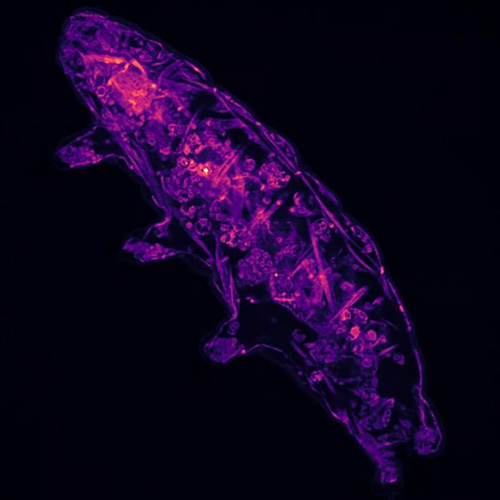Molecular sensor enables water bear hardiness by triggering dormancy
Tardigrades – hardy, microscopic animals commonly known as “water bears” – use a molecular sensor that detects harmful conditions in their environment, telling them when to go dormant and when to resume normal life. A team led by Derrick R. J. Kolling of Marshall University and Leslie M. Hicks of the University of North Carolina at Chapel Hill report these findings in a new study published January 17 in the open-access journal PLoS ONE.

Water bears are famous for their ability to withstand extreme conditions, and can survive freezing, radiation, and environments without oxygen or water. They persist by going dormant and entering a tun state, in which their bodies become dehydrated, their eight legs retract and their metabolism slows to almost undetectable levels. Previously, little was known about what signals water bears to enter and leave this state.
In the new study, researchers exposed water bears to freezing temperatures or high levels of hydrogen peroxide, salt or sugar to trigger dormancy. In response to these harmful conditions, the animals’ cells produced damaging oxygen free radicals. The researchers found that water bears use a molecular sensor—based on the amino acid cysteine—which signals the animals to enter the tun state when it is oxidized by oxygen free radicals. Once conditions improve and the free radicals disappear, the sensor is no longer oxidized, and the water bears emerge from dormancy. When the researchers applied chemicals that block cysteine, the water bears could not detect the free radicals and failed to go dormant.
Altogether, the new results indicate that cysteine is a key sensor for turning dormancy on and off in response to multiple stressors, including freezing temperatures, toxins and concentrated levels of salt or other compounds in the environment. The findings suggest that cysteine oxidation is a vital regulatory mechanism that contributes to water bears’ remarkable hardiness and helps them survive in ever-changing environments.
"Our work reveals that tardigrade survival to stress conditions is dependent on reversible cysteine oxidation, through which reactive oxygen species serve as a sensor to enable tardigrades to respond to external changes," the authors stated.Enjoy reading ASBMB Today?
Become a member to receive the print edition four times a year and the digital edition monthly.
Learn moreGet the latest from ASBMB Today
Enter your email address, and we’ll send you a weekly email with recent articles, interviews and more.
Latest in Science
Science highlights or most popular articles

Bacteriophage protein could make queso fresco safer
Researchers characterized the structure and function of PlyP100, a bacteriophage protein that shows promise as a food-safe antimicrobial for preventing Listeria monocytogenes growth in fresh cheeses.

Building the blueprint to block HIV
Wesley Sundquist will present his work on the HIV capsid and revolutionary drug, Lenacapavir, at the ASBMB Annual Meeting, March 7–10, in Maryland.

Gut microbes hijack cancer pathway in high-fat diets
Researchers at the Feinstein Institutes for Medical Research found that a high-fat diet increases ammonia-producing bacteria in the gut microbiome of mice, which in turn disrupts TGF-β signaling and promotes colorectal cancer.

Mapping fentanyl’s cellular footprint
Using a new imaging method, researchers at State University of New York at Buffalo traced fentanyl’s effects inside brain immune cells, revealing how the drug alters lipid droplets, pointing to new paths for addiction diagnostics.

Designing life’s building blocks with AI
Tanja Kortemme, a professor at the University of California, San Francisco, will discuss her research using computational biology to engineer proteins at the 2026 ASBMB Annual Meeting.

Cholesterol as a novel biomarker for Fragile X syndrome
Researchers in Quebec identified lower levels of a brain cholesterol metabolite, 24-hydroxycholesterol, in patients with fragile X syndrome, a finding that could provide a simple blood-based biomarker for understanding and managing the condition.

